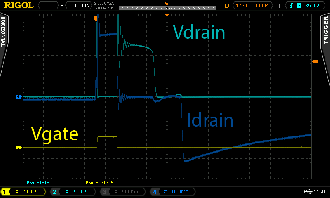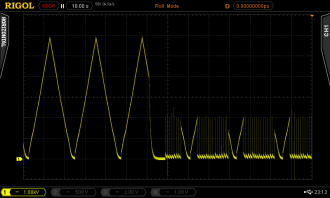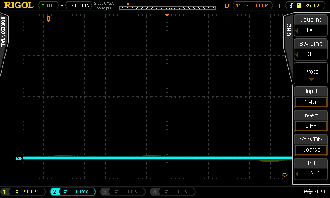Jennifer In Control
User Tools
Sidebar
Table of Contents
EStims operate in bursts of up to about 300V and 100mA. Even though these bursts are short – the estim is “off” 98% of the time even at its highest setting – most electronic components are designed to handle upwards of a few volts and most power electronic components are designed to handle upwards of tens of volts. Short bursts of ten or a hundred times the rated voltage are likely to cause run of the mill switches to misbehave or die.
Fortunately, switches are cheap well into the 1000V+ range, so the problem is not inherently difficult, but run-of-the-mill switches are not overengineered enough to make “buy the cheapest switch on ebay and hope for the best” a reliable strategy. On this page I'll use my 6000V power supply and oscillscope to torture-test some common components so that you don't have to.
Spoiler: everything we discover is exactly what one would expect from reading the datasheets.
The Good
2SK3568 MOSFET
- Good to 500V, well over the 300V needed
- Trigger option: arduino
- This is the best option on this page to use with an arduino due to low current requirement and ultra-fast switching. The relay can let estim pulses through or block thim; this switch can pass 1/2 or 1/3 or 1/10th of a pulse.
- Trigger option: USB with port power toggling app.
- Trigger option: audio → peak-holder circuit (OpAmp, diode, R, C, breadboard+wires)
- Trigger option: audio → amplifier + diode
SMAKN Wide Voltage Power Supply Adjustable Trigger Relay Module
- Good to 2000V, well over the needed 300V.
- Trigger option: arduino
- Trigger option: USB with port power toggling app.
- Trigger option: audio into NPN transistor (it'll get a solid latch off a 2 microsecond pulse!)
The Bad
TIP31C BJT
- Not good to 300V, which is what we need.
- Good to 250V, which is almost 400% of its rated maximum voltage, so we can't really blame it.
- Is that close enough? Not really; it leaks the estim current when open.
- It might work if the moon and stars align.
- hFE too low to reliably use audio output as gating current (see audio output article).
The Ugly
I have yet to kill a single transistor or relay, despite hooking them up to 6kV. This is likely because most modern components are designed to gracefully handle static electricity (2kV+); as long as the amount of current is tiny, the voltage doesn't actually deliver much power (voltage * current), and power is the thing that melts, burns, and explodes.










